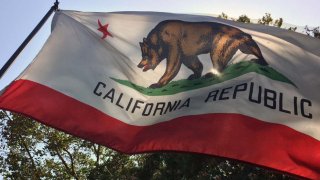
New California congressional maps finalized Monday leave the Los Angeles area with one fewer U.S. House seat and set up a handful of highly competitive races for next year's midterm elections.
The California Citizens Redistricting Commission was tasked with drawing new state political maps based on census data, a process that happens once every 10 years. California lost a U.S. House seat for the first time, going from 53 to 52, because the state grew more slowly than others. But the state of nearly 40 million people still has by far the largest House delegation.
The borders of each California seat shifted slightly to fit the requirement that they represent 760,000 people. But it was the LA-area seat held by Democratic Rep. Lucille Roybal-Allard that was effectively eliminated, with a huge portion of her district folding into another in Long Beach. Roybal-Allard, the first Mexican American woman elected to Congress, announced Monday she won't seek re-election.
Get Southern California news, weather forecasts and entertainment stories to your inbox. Sign up for NBC LA newsletters.
Nor will Democratic Rep. Alan Lowenthal, who currently represents Long Beach. The city's mayor, Democrat Robert Garcia, has already announced plans to run for Congress. Garcia is a close ally of Vice President Kamala Harris and California Gov. Gavin Newsom.
Though California is a heavily Democrat state, it also has Republican strongholds in the northern region and parts of the agricultural Central Valley, home to House Minority Leader Kevin McCarthy. The GOP currently holds 11 of California's 53 seats.
Local
Get Los Angeles's latest local news on crime, entertainment, weather, schools, COVID, cost of living and more. Here's your go-to source for today's LA news.
Democrats have more registered voters in 43 of the newly drawn districts, according to California Target Book, an organization that analyzes redistricting data. But a registration edge doesn’t always translate to electorate wins.
The Central Valley and suburban Orange County have seen some of the country's most competitive U.S. House races in recent midterm elections, and that's poised to continue with the new maps. Democrats knocked off seven Republicans in 2018, only for the GOP to take four of those seats back in 2020.
The borders of Fresno area districts represented by Democratic Rep. Jim Costa and Republican Reps. David Valadao and Devin Nunes shifted significantly. Nunes has already announced he won't run for re-election and plans to lead a media organization launched by former President Donald Trump. Like Valadao, Democratic Rep. Josh Harder saw his Modesto-area district sliced almost in half, perhaps creating a more complicated path to re-election.
In Orange County, a major piece of Democratic Rep. Katie Porter’s district, including Irvine, has been combined with beach communities along the coast that make up the bulk of Republican Michelle Steel’s district, potentially creating a race between the two incumbents. The new district has a miniscule registration edge for Republicans. Porter is a fundraising powerhouse with more than $14 million in her campaign account. Steel, meanwhile, has $1.3 million.
Elsewhere, the suburban Los Angeles County district held by Republican Rep. Mike Garcia grew slightly more Democratic, while the coastal district represented by Democratic Rep. Mike Levin that includes Carlsbad and Oceanside turned slightly less Democratic.
California is one of 10 states that relies on an independent commission to draw lines, rather than judges or partisan lawmakers, according to the National Conference of State Legislatures.
Commissioners aren’t allowed to consider a district’s partisan makeup when drawing lines. Alongside creating districts with even population, the state constitution requires the commission to consider geographic continuity and compliance with the Voting Rights Act, which sets rules for racial representation.
Latinos, who account for 40% of California’s population, will make up a majority of the voting-age population in 16 of the 52 new districts, said Evan McLaughlin, a redistricting expert who works with Democrats.
The 14-member commission included five registered Republicans, five registered Democrats and four people registered without a political party. They were selected through a lengthy process run by the state auditors office. Voters created the commission in 2008 in an effort to remove partisanship from the process of drawing new political lines.
“I’m so proud of the work that together we have completed to serve all Californians," Commissioner Pedro Toledo, who has no party affiliation, said as the commission finished reviewing the proposed lines. “Despite a difference of opinion at times, there was always commitment to our common goal: The goal of creating representative and fair maps for all Californians."
The commission faced some criticism for a lack of transparency. Commissioners regularly made map changes in live meetings and sometimes did not upload the new maps for days, making it difficult for the public to understand the changes. Delayed Census data due to the pandemic shortened how much time the commission had to complete its work.
Other California lawmakers who don't plan to seek reelection are Democratic Rep. Jackie Speier, who represents the San Francisco Bay Area, and Democratic Rep. Karen Bass, who plans to run for mayor of Los Angeles.



